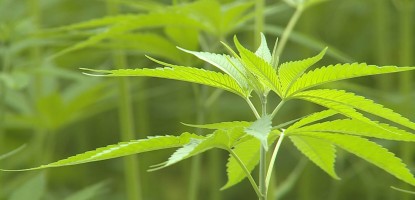Hempcrete: Plant-Based Sustainable Building Materials

Hempcrete is made from the hemp plant's inner woody core and mixed with a binder to create a lightweight biocompatible material. This plant-based building material is breathable, fire resistant, and CO2 sequestering. Hempcrete is the answer whether you want a green home or a more comfortable, safe home.
Hempcrete is a plant-based sustainable building material.
Hempcrete is a multi-performance building material that replaces mineral aggregates in conventional concrete. In historic buildings, hemp stalks were used in the construction process to increase their strength and thermal and hydrothermal performance. Additionally, hempcrete is a carbon-storing building envelope. The production process consists of mixing hemp with a natural binder.
Hempcrete has many advantages over traditional concrete. It has superior ecologic qualities, has a higher thermal conductivity than concrete, and contributes to the well-being of its users. Additionally, hemp concrete is highly resistant to water, making it a great choice for building projects in humid climates.
The process of making hempcrete can be simple or complicated. It can be used to construct various structures, such as fences, walls, and floors. It can be incorporated into a prefabricated building block. Prefabricated blocks are made of hemp, with a bioplastic structure. These structures can be retrofitted with hemp insulation or can be added to a wooden frame.
Hemp sequesters CO2
Hempcrete reduces greenhouse gas emissions because it sequesters more CO2 than any other commercial crop. For this reason, hempcrete production and use reduce carbon footprints.
Scientists have found that hemp is an excellent sequester of carbon dioxide. Hempcrete is made of hemp fibers mixed with a lime-based binder. Hempcrete can sequester more than 100 kilograms of CO2 per square meter of building surface.
A typical hempcrete house would sequester 110kg of carbon from the atmosphere over its lifetime. An average-sized house would use about 50 cubic meters of hempcrete for its walls. This would lock in about 5.5 tons of carbon over its lifetime. A standard new house wall would release approximately 48 tons of carbon into the atmosphere. Hempcrete walls would sequester 53.5 tons of carbon for every house built.
The construction industry is responsible for 30 percent of the world's annual greenhouse gas emissions and consumes about 40 percent of energy. Hempcrete has the potential to make these buildings zero-carbon structures.
Hemp is breathable
Hempcrete is a breathable and flexible building material. It does not lose its malleability as it becomes tougher. Hempcrete construction can last for thousands of years. It does not crack, even in the face of small earthquakes. Its breathable nature is a major benefit of this material. Hempcrete is also very insulating.
Hempcrete can be applied directly to the floor or over an existing subfloor.
Unlike other concrete, hempcrete blocks are extremely lightweight, reducing the energy necessary for transporting the building materials. Hempcrete also has high cellulose content, meaning it does not produce carbon. This is a significant advantage in a building project, as the concrete will not retain moisture, thus reducing energy use.
Hemp is fire resistant
Hempcrete is fire resistant, making it an excellent choice for homes in areas at risk of wildfires. This type of concrete is made from hemp stalks, a lime binder, and water. It can be made in three easy steps - mixing, molding, and curing. The ratios of these materials are key in producing the most resilient building material. In addition to its fire resistance, hempcrete has excellent thermal and acoustic properties.
Hempcrete is also highly efficient at absorbing and releasing energy. This slow release of energy stabilizes day-to-night temperature fluctuations. Because of its lightweight nature, hempcrete retains heat more quickly and requires less energy to heat and cool it. Its primary function as a building material is as thermal wall mass.
Hemp regulates moisture
The high water absorption and thermal inertia of hempcrete make it an excellent choice for building envelopes. Because of these features, it reduces heating and cooling costs by seven to 8%. Hempcrete's moisture-regulating properties contribute to an overall 10% energy saving. Its high moisture absorption properties also make it a superior choice for exterior walls.
Hempcrete has these properties because of its high porosity and moisture buffer value of 2 g/(m2), which allow it to gain thermal mass. This prevents fluctuations in indoor temperatures due to fluctuating indoor temperatures. Hempcrete also contributes to moderate indoor relative humidity, which reduces energy consumption.
The low density of hempcrete makes it an excellent choice for earthquake-prone regions. The material also breaks down slowly, allowing the cement to cure without cracks.
Hemp is a low-medium density
Cast-in-situ hempcrete forms a monolithic insulating layer within the fabric of a building. The material can be cast into almost any shape required by design, minimizing thermal bridging and providing exceptional airtightness. Hempcrete is a low-medium density, a plant-based building material that is also exceptionally low-impact. The embodied energy of hempcrete is considered in conjunction with considerations of prefabrication and transport to the building site.
Its high thermal inertia and moisture buffering properties enable it to reduce energy use in buildings by as much as 12-17%. Its natural resilience to water and UV radiation makes it suitable for new build and renovation projects. Hempcrete is a sustainable building material for both new and historic structures. The materials contain no fossil fuels, have high strength, and are biodegradable, making them a great choice for constructing new buildings.
Developed in France in the mid-80s to replace deteriorated wattle-and-daub in medieval timber-framed buildings, hempcrete has become an increasingly popular choice for new builds.
Hemp is a structural material
Hempcrete is a sustainable building material that can adapt to a cold climate. Although it lacks the mechanical strength of steel concrete, it is light and durable enough to be used in mainstream building applications. Additionally, the concrete is a bioplastic, meaning it will not break down easily in a wet climate. Therefore, hempcrete can help reduce pressure on forests around the world. It also contributes to combating global warming, reducing the need to import wood from other countries.
Final Thoughts
The construction industry consumes 40% of the world's resources and energy, and using synthetic materials for construction can increase toxic levels in buildings. Hempcrete is lightweight, reducing the energy used to transport blocks. It also acts as a moisture-regulating material and insulator. It also lacks the brittleness of concrete, eliminating the need for expansion joints. As a result, it requires less maintenance than concrete and can be an excellent investment.

As a plant-based biomaterial, hempcrete is an excellent choice for environmentally-conscious homeowners because it binds more atmospheric carbon during the life of a building. That means that the hempcrete building you build will trap more carbon in the atmosphere than any other building material you can find.






Leave a Comment